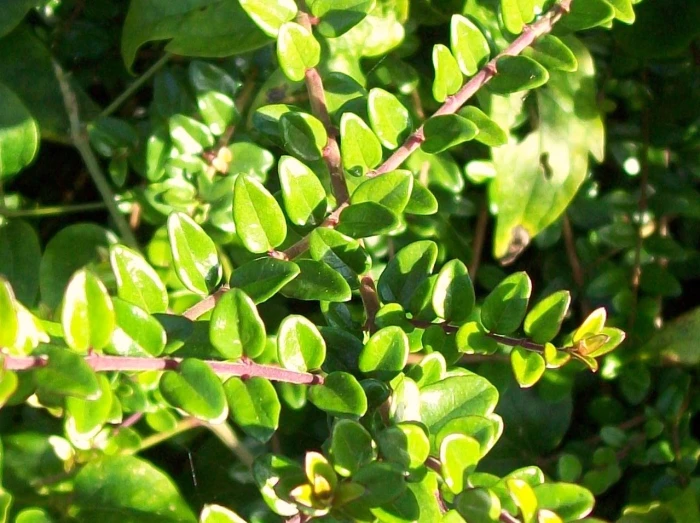Box Honeysuckle
(Lonicera nitida)
Box Honeysuckle (Lonicera nitida)
/
/

AnemoneProjectors (talk)
CC BY-SA 2.0
Image By:
AnemoneProjectors (talk)
Recorded By:
Copyright:
CC BY-SA 2.0
Copyright Notice:
Photo by: AnemoneProjectors (talk) | License Type: CC BY-SA 2.0 | License URL: https://creativecommons.org/licenses/by-sa/2.0 | Uploader: Rudolphous | Publisher: Wikimedia Commons | Title: Boxleaf_Honeysuckle_(Lonicera_nitida)_(3907165157).jpg | Notes: Uploaded own work with UploadWizard |














































Estimated Native Range
Climate Requirements
| • Precipitation | 34" - 41" |
| • High Temp. | 66°F - 74°F |
| • Low Temp. | Unknown°F - 37°F |
Summary
Lonicera nitida, commonly known as Box Honeysuckle or Wilson’s Honeysuckle, is an evergreen shrub native to China, particularly in scrub and forest clearings. It typically grows 4–5 ft (1.2–1.5 m) tall and 4–6 ft (1.2–1.8 m) wide if left unpruned, featuring dense, dark green, small leaves. The creamy white, fragrant flowers, which are 6 millimeters long and grow in pairs, bloom in late spring and are modest in showiness. The plant also produces small, purple-black berries that are attractive to wildlife but are not particularly ornamental.
Box Honeysuckle is valued for its dense foliage and is widely used as a low hedging plant, for topiary, and as a ground cover in urban landscaping due to its tolerance of drought and pollution. It is more shade-tolerant than most honeysuckles, making it versatile in garden design. The species is easy to clip and requires frequent pruning to maintain shape, especially as it can become floppy if allowed to grow over 5 feet tall. It is also popular for bonsai. The cultivar ‘Baggesen’s Gold’ has gained the Royal Horticultural Society’s Award of Garden Merit for its attractive golden-yellow foliage. In cultivation, Lonicera nitida thrives in full sun to part shade, with medium water requirements, and adapts to a range of soil drainage conditions from slow to fast. Despite its benefits, it can become invasive if not managed properly, so gardeners should be mindful of its spreading habit.CC BY-SA 4.0
Box Honeysuckle is valued for its dense foliage and is widely used as a low hedging plant, for topiary, and as a ground cover in urban landscaping due to its tolerance of drought and pollution. It is more shade-tolerant than most honeysuckles, making it versatile in garden design. The species is easy to clip and requires frequent pruning to maintain shape, especially as it can become floppy if allowed to grow over 5 feet tall. It is also popular for bonsai. The cultivar ‘Baggesen’s Gold’ has gained the Royal Horticultural Society’s Award of Garden Merit for its attractive golden-yellow foliage. In cultivation, Lonicera nitida thrives in full sun to part shade, with medium water requirements, and adapts to a range of soil drainage conditions from slow to fast. Despite its benefits, it can become invasive if not managed properly, so gardeners should be mindful of its spreading habit.CC BY-SA 4.0
Plant Description
- Plant Type: Shrub
- Height: 5-8 feet
- Width: 4-7 feet
- Growth Rate: Rapid
- Flower Color: Cream, White
- Flowering Season: Spring, Summer
- Leaf Retention: Evergreen
Growth Requirements
- Sun: Full Sun, Part Shade
- Water: Medium
- Drainage: Slow, Medium, Fast
Common Uses
Bank Stabilization, Bee Garden, Bird Garden, Border Plant, Butterfly Garden, Deer Resistant, Drought Tolerant, Erosion Control, Fragrant, Groundcover, Hedges, Hummingbird Garden, Rabbit Resistant, Salt Tolerant, Street Planting
Natural Habitat
Native to scrub and forest clearings in China
Other Names
Common Names: Compact Box Honeysuckle
Scientific Names: Lonicera nitida, Lonicera pileata var. yunnanensis, Lonicera ligustrina var. yunnanensis, Lonicera ligustrina subsp. yunnanensis, Lonicera pileata f. yunnanensis, Chamaecerasus nitida, Lonicera lanceolata subsp. yunnanensis, Lonnicera nitida
GBIF Accepted Name: Lonicera pileata var. yunnanensis (Franch.) Bernd Schulz